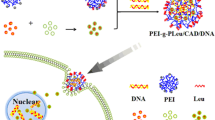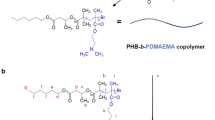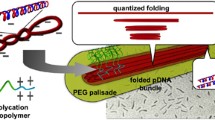Abstract
Gene therapy based on non-viral synthetic delivery vectors has attracted much attention in the past two decades. However, it is still in clinical trial stages, mainly due to the lack of safe and efficient delivery vehicles. Herein, we report on the synthesis and DNA complexation ability of novel, hybrid copolymer comprising poly(N-isopropylacrylamide) (PNIPAm) block with poly(ethylene glycol) (PEG) side chains and a polycationic block of poly(l-lysine) (PLLys). The copolymer was synthesized in a two-step procedure. In the first step, a thermally sensitive PNIPAm-g-PEG copolymer with terminal ammonium hydrochloride group was prepared. The second step involves controlled ring-opening polymerization of Z-l-lysine N-carboxyanhydride initiated by the PNIPAm-g-PEG macroinitiator. The hybrid copolymer obtained show high ability to condense DNA into stable polyplexes with sizes below 100 nm. Cytotoxicity evaluation of both hybrid copolymer and its polyplex with DNA indicates that it might be a good candidate for gene-delivery applications.









Similar content being viewed by others
References
Baum C, Kustikova O, Modlich U, Li Z, Fehze B (2006) Mutagenesis and oncogenesis by chromosomal insertion of gene transfer vectors. Hum Gene Ther 17:253–263
Check E (2002) Gene therapy: a tragic setback. Nature 420:116–118
Cho YW, Kim Y-D, Park K (2003) Polycation gene delivery systems: escape from endosomes to cytosol. J Pharm Pharmacol 55:721–734
Choi YH, Liu F, Kim J-S, Choi YK, Park YS, Kim SW (1998) Polyethylene glycol-grafted poly-l-lysine as polymeric gene carrier. J Control Release 54:39–48
Dash PR, Read ML, Barrett LB, Wolfert MA, Seymour LW (1999) Factors affecting blood clearance and in vivo distribution of polyelectrolyte complexes for gene delivery. Gene Ther 6:643–650
de Ilarduya CT, Sun Y, Düzgüneş N (2010) Gene delivery by lipoplexes and polyplexes. Eur J Pharm Sci 40:159–170
Dimitrov I, Schlaad H (2003) Synthesis of nearly monodisperse polystyrene-polypeptide block copolymers via polymerisation of N-carboxyanhydrides. Chem Commun 23:2944–2945
Dimitrov I, Berlinova I, Vladimirov N (2006) Synthesis of poly(oxyethylene)-poly(Z-l-lysine) hybrid graft copolymers. Macromolecules 39:2423–2426
Dimitrov I, Trzebicka B, Müller AHE, Dworak A, Tsvetanov C (2007) Thermosensitive water-soluble copolymers with doubly responsive reversibly interacting entities. Prog Polym Sci 32:1275–1343
Dimitrov I, Berlinova I, Iliev P, Vladimirov N (2008) Controlled synthesis of peptide-based amphiphilic copolymers. Macromolecules 41:1045–1049
Dimitrov I, Petrova E, Kozarova R, Apostolova M, Tsvetanov C (2011) A mild and versatile approach for DNA encapsulation. Soft Matter 7:8002–8004
Du F-S, Wang Y, Zhang R, Li Z-C (2010) Intelligent nucleic acid delivery systems based on stimuli-responsive polymers. Soft Matter 6:835–848
Gil ES, Hudson SM (2004) Stimuli-responsive polymers and their bioconjugates. Prog Polym Sci 29:1173–1222
Grigsby CL, Leong KW (2010) Balancing protection and release of DNA: tools to address a bottleneck of non-viral gene delivery. J R Soc Interface 7:S67–S82
Grisham J (2000) Inquiry into gene therapy widens. Nat Biotechnol 18:254–255
Hinrichs WLJ, Schuurmans-Nieuwenbroek NME, van de Wetering P, Hennink WE (1999) Thermosensitive polymers as carriers for DNA delivery. J Control Release 60:249–259
Itaka K, Harada A, Nakamura K, Kawaguchi H, Kataoka K (2002) Evaluation by fluorescence resonance energy transfer of the stability of nonviral gene delivery vectors under physiological conditions. Biomacromolecules 3:841–845
Kakizawa Y, Kataoka K (2002) Block copolymer micelles for delivery of gene and related compounds. Adv Drug Deliv Rev 54:203–222
Karmali PP, Chaudhuri A (2007) Cationic liposomes as non-viral carriers of gene medicines: resolved issues, open questions, and future promises. Med Res Rev 27:696–722
Kurisawa M, Yokoyama M, Okano T (2000) Gene expression control by temperature with thermo-responsive polymeric gene carriers. J Control Release 69:127–137
Lavigne MD, Pennadam SS, Ellis J, Yates LL, Alexander C, Górecki DC (2007) Enhanced gene expression through temperature profile-induced variations in molecular architecture of thermoresponsive polymer vectors. J Gene Med 9:44–54
LePecq J-B, Paoletti C (1967) A fluorescent complex between ethidium bromide and nucleic acids. Physical–chemical characterization. J Mol Biol 27:87–106
Mosmann T (1983) Rapid colorimetric assay for cellular growth and survival: application to proliferation and cytotoxicity assays. J Immunol Methods 65:55–63
O’Rorke S, Keeney M, Pandit A (2010) Non-viral polyplexes: scaffold mediated delivery for gene therapy. Prog Polym Sci 35:441–458
Oupický D, Reschel T, Koňak Č, Oupická L (2003) Temperature-controlled behavior of self-assembly gene delivery vectors based on complexes of DNA with poly(l-lysine)-graft-poly(N-isopropylacrylamide). Macromolecules 36:6863–6872
Poché D, Moore M, Bowles J (1999) An unconventional method for purifying the N-carboxyanhydride derivatives of γ-alkyl-l-glutamates. Synth Commun 29:843–854
Roques C, Fattal E, Fromes Y (2009) Comparison of toxicity and transfection efficiency of amphiphilic block copolymers and polycationic polymers in striated muscles. J Gene Med 11:240–249
Schaffer DV, Fidelman NA, Dan N, Lauffenburger DA (2000) Vector unpacking as a potential barrier for receptor-mediated polyplex gene delivery. Biotechnol Bioeng 67:598–606
Shen Z, Shi B, Zhang H, Bi J, Dai S (2012) Exploring low-positively charged thermosensitive copolymers as gene delivery vectors. Soft Matter 8:1385–1394
Soliman M, Allen S, Davies MC, Alexander C (2010) Responsive polyelectrolyte complexes for triggered release of nucleic acid therapeutics. Chem Commun 46:5421–5433
Trentin D, Hubbell J, Hall H (2005) Non-viral gene delivery for local and controlled DNA release. J Control Release 102:263–275
Vinogradov SV, Bronich TK, Kabanov AV (1998) Self-assembly of polyamine-poly(ethylene glycol) copolymers with phosphorothioate oligonucleotides. Bioconjug Chem 9:805–812
Wong SY, Pelet JM, Putnam D (2007) Polymer systems for gene delivery—past, present, and future. Prog Polym Sci 32:799–837
Zintchenko A, Ogris M, Wagner E (2006) Temperature dependent gene expression induced by PNIPAM-based copolymers: potential of hyperthermia in gene transfer. Bioconjug Chem 17:766–772
Acknowledgments
This study was financially supported by the Bulgarian National Science Fund through a project “Ideas” DO 02-247/2008.
Author information
Authors and Affiliations
Corresponding author
Electronic supplementary material
Below is the link to the electronic supplementary material.
Rights and permissions
About this article
Cite this article
Ivanova, E., Dimitrov, I., Kozarova, R. et al. Thermally sensitive polypeptide-based copolymer for DNA complexation into stable nanosized polyplexes. J Nanopart Res 15, 1358 (2013). https://doi.org/10.1007/s11051-012-1358-7
Received:
Accepted:
Published:
DOI: https://doi.org/10.1007/s11051-012-1358-7




